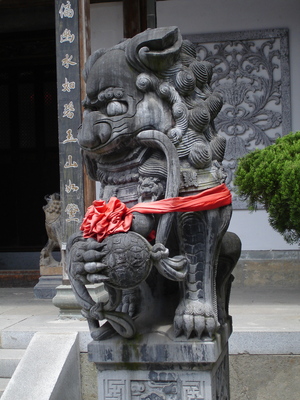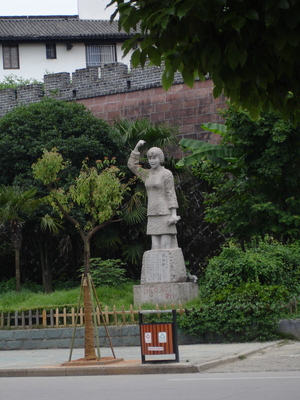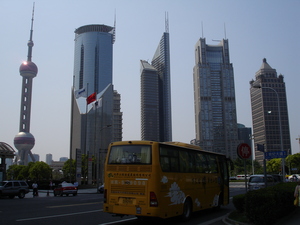We were left up to our own devices for breakfast today, so some friends and I walked about a block down the road to a street vendor selling omelets to go. The dough and egg exterior was used like a pita sandwich in which the vegetable or meat fillings of our chose were sealed. Mine was about the tastiest thing I’ve ever had for the first meal of the day.
By the time I’d finished eating, our bus had arrived at the World Expo. It became immediately clear that this event is more like a theme park than anything else, which explains why Disney World modeled its Epcot Center after the World Expositions. The Shanghai Expo is on land that used to be a shipyard but was moved by the government to make way for the Expo (the Chinese are getting really good at relocating people and facilities). Its grounds extend on both sides of the Huangpu River, so free ferries shuttle visitors across.
They’ll tell you that each country has its own “pavilion,” but the quoted word is the greatest understatement of our trip to China. Each country’s structure was a monument to the creativeness of its people. Brushed steel columns at impossible angles, giant domes of transparent glass, and gardens on vertical walls–we saw them all, and much more. China’s structure is a gigantic, upside down stepped pyramid. Many of the pavilions also include their own restaurant with the traditional food of the country. The insides of these structures are as varied as their exteriors. There are movie theatres, concert halls, exhibition rooms, interactive environments, gigantic lifelike baby robots (Germany) and bicycling ramps (found in Denmark’s pavilion, where bicycles are available for those interested in riding). Water effects seemed to be especially popular. Indoor fountains and waterfalls on the walls weren’t rare.


The Chinese Pavilion
Awesomeness comes at a price, and at the World Expo, this is paid by waiting in line (in addition to your admittance fee). Furthermore, these aren’t your standard theme park queues. For some countries’ pavillions, like those of China, the U.S., Japan, and Korea, the lines can take three hours to get through, and that’s if you match the aggression of the Chinese visitors. The rows are often three or four people wide, and unless you and several friends form a human blockade, expect to get cut by a dozen people every time you leave more than six inches between you and the person in front. It’s standard practice for those waiting behind you to press until their toes touch your heels, and their bags and elbows dig into your backside. I found that if I waited in line while balancing only on my toes, the people behind me would shimmy their feet under my heels. As I slowly shifted my weight back to normal, they would have to pull back and give me some space or lose their toes. Another technique that worked very well was to lean backwards against those behind you until you pushed them back a few inches, and then to return quickly to a normal position. This is all done without exchanging glances or words, but after three hours or so it definitely gets personal.
The most aggressive people were the older ones (those under thirty usually found the behavior to be as bizarre as we did), and these were also the ones who don’t speak English. By the end of a line, our greatest foes had codenames (ex. plaid shirt lady), and it became our mission to ensure that we beat them in the race to the pavilion entrance. While the competition in lines was definitely occurring between every group of individuals, at times we felt like we received just a slightly harsher treatment because we were so obviously foreigners. Part of the problem was that it was easy to tell that we were all part of the same group, but we couldn’t tell when others were. Sometimes a child would slip by our knees and we would allow it, figuring that he was catching up to his family, only to discover that they was behind us using the boy as an excuse to cut past. Other times, a woman would slip by and then link arms with three of her friends, pulling them between us before we could close the gap. Lastly, whenever the line opened up into any kind of space, even if it was an entrance hallway to the pavilion and it was clear that they would be in the next batch of people to enter no matter what, members of the line would break into a sprint to try to reach the next room first.
It’s important to distinguish what I’ve written above from any kind of a slight on the Chinese people or culture. Their way of handling lines is much more aggressive than ours, and felt bizarre at fist. However, in traveling, one has to understand that there are no better or worse traditions–only different ones. This is a concept that Sven has been doing a great job of reinforcing for us on the rare cases when we are guilty of frustration by a divergence from the American way. Most of my favorite moments in the day actually occurred as we learned the trade of waiting in lines, just as we learned how to barter earlier in the month. I must admit that without such pressure to advance in line, three-hour waits could easily have been double that duration.
Returning my account to the pavilions themselves, I personally had the chance to visit Israel, Russia, Monaco, Japan, and a join pavilion for the smaller of the African nations. Israel’s had a 360 degree movie theatre where they presented some of the nation’s research in science and technology, including micro snake-like robots designed to enter a person’s body and perform operations. Russia took a two-level approach to their building. Parts of it made me feel like I was in a fantasy world. Giant artificial vegetables were arranged around the walkway, and every couple of feet there was a booth on which a projection screen displayed one of several children in strange costumes giving talks in Chinese on Russia’s culture and technology. Replicas of famous spacecrafts hung from the ceiling, most notably Sputnik.

Israel’s Pavilion

Inside Russia’s Pavilion
Monaco’s pavilion was essentially a movie theatre that displayed a silent animated movie of scenes of Monaco’s history, from its original colonization to the battles in which it changed from the possession of one nation to another to its current growth and development. In the last seconds of the video, it proposed a view of the Principality in the year 3000, where flying ships became a part of its habitat as well as the mainland.
The joint Africa pavilion was divided into smaller stalls for its nations, which each displayed artifacts and exhibits detailing some notable citizens and cultural and artistic trends. The booth for Kenya featured a picture of Barack Obama and a paragraph or two about his Kenyan lineage. Several of the countries had displays honoring their notable Olympic athletes.
Japan’s pavilion was my final stop, and my favorite of the day. In addition to having some walk-through exhibits on advancements in energy and water purification, it had several auditoriums where staff members gave presentations on Japanese technology. One of the focuses was a new handheld digital photography camera with an unbelievably high resolution. They also showed off a robot that can not only walk but also play simple tunes on the violin. Lastly, they rode around in a single person vehicle that was like a combination between a Smart Car and a Segue. All of this technology was tied in to Japan’s efforts to help reestablish China’s crested ibis (http://en.wikipedia.org/wiki/Crested_Ibis) population, and followed a family of the future in their discovery that the bird had made a comeback. The presentations also mixed in some traditional interpretive Japanese dancing on stage.

Japan’s robot
The use of the crested ibis was just one instance of countries attempting to paint themselves as having a rich and mutually beneficial relationship with the Chinese. Much like Armstrong and GE, they knew that success in China depends upon making the case that they have China’s best interests in mind.
Several pavilions at the Expo were not related to any one country, but instead had been constructed around the theme and mission of the Expo itself. We visited the “Urbanian Pavilion” that traced the parallel lives of several families in different areas of the world through each of five rooms titled: Family, work, contact, learning, and health. In the rooms, a monitor for each family displayed a short video focused around that room’s title. All the videos in a room were coordinated, so as you looked around you saw how each family performed similar activities in different ways.
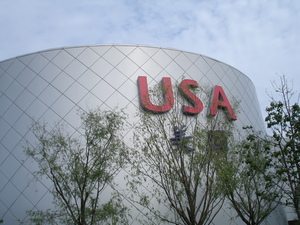
The USA Pavilion
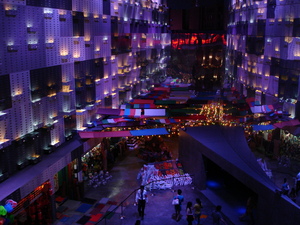
The Urbanian Pavilion
The only pavilion I wish I could have visited but did not get the chance to was the United States’. From what I’m told by others in our group who did attend, it had three different auditoriums, each with a video of about five minutes in length, and featured dialogues by some famous Americans. President Obama was one of the more notable speakers. The final video included an effect that actually sprinkled water droplets on the crowd as a storm raged onscreen. Few of us were surprised to see that KFC and Pizza Hut had locations right next to the U.S. pavilion.


A few more pavilions
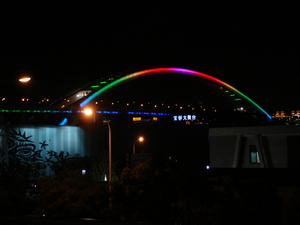
A bridge of the World Expo
Despite having had Mexican (or the Chinese take on it, at least) for lunch, I was starving by the time we returned to our hotel around midnight. A few of us had a late dinner with Xinli at the restaurant next door to the hotel before heading to our rooms with ankles still sore after spending an entire day on our feet.
Location: Shanghai, China






